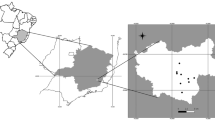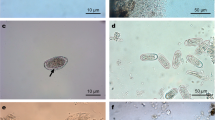Abstract
The aims of the study were to determine fecundity of several strongylid species parasitizing domestic horses and analyze possible relations between numbers of eggs in female uteri and size of both the eggs and the nematodes as well as the influence of fecundity on proportion of species in the strongylid community. Twenty-five specimens from each of 15 strongylid species (Strongylus vulgaris, Strongylus edentatus, Triodontophorus serratus, Triodontophorus brevicauda, Triodontophorus tenuicollis, Cyathostomum catinatum, Coronocyclus coronatus, Cylicocyclus nassatus, Cylicocyclus insigne, Cylicocyclus leptostomus, Cylicostephanus calicatus, Cylicostephanus goldi, Cylicostephanus longibursatus, Cylicostephanus minutus, and Poteriostomum imparidentatum) collected after necropsy were studied. The reproductive system was extracted from the female body; all eggs were removed, counted, and measured under a light microscope. Significant differences in number of eggs in female uteri of various strongylid species were observed (Kruskal–Wallis test, p < 0.001); the least numbers of eggs were registered in C. longibursatus (average = 49) and C. leptostomus (63) and the largest number in S. edentatus (5,918). Significant correlation between nematode body size and number of eggs was observed (p < 0.001). Correlation between size of eggs and body size was insignificant (Spearman R = 0.11, p = 0.70). Negative correlation was observed between number of eggs in female uteri and proportion of these species in strongylid community (Spearman R = −0.78, p < 0.001). Multiple linear regression of species proportion in the community on three predictors (number of eggs, body size, and egg size) was not significant (p > 0.05). However, the question on influence of fecundity on proportion of species in strongylid community needs further studies.





Similar content being viewed by others
References
Anderson RM, May RM (1978) Regulation and stability of host-parasite population interaction. I. Regulatory processes. J Anim Ecol 47:219–247
Armour J (1980) The epidemiology of helminth disease in farm animals. Vet Parasitol 6:7–46
Boulenger CL (1920) On some nematode parasites of the zebra. Parasitol 12:98–107
Bowman DD, Lynn RC (1995) Parasitology for veterinarians, 6th edn. Saunders, Philadelphia
Bucknell DG, Gasser RB, Beveridge I (1995) The prevalence and epidemiology of gastrointestinal parasites of horses in Victoria, Australia. Int J Parasitol 25:711–724
Chapman MR, French DD, Klei TR (2003) Prevalence of strongyle nematodes in naturally infected ponies of different ages and during different seasons of the year in Louisiana. J Parasitol 89:309–314
Collobert-Laugier C, Hoste H, Sevin C, Dorchies P (2002) Prevalence, abundance and site distribution of equine small strongyles in Normandy, France. Vet Parasitol 110:77–83
Corning S (2009) Equine cyathostomins: a review of biology, clinical significance and therapy. Parasite Vectors 2(Suppl 2):1–6
Crofton HD (1971) Quantitative approach to parasitism. Parasitol 62:179–193
Denwood MJ, Love S, Innocent GT, Matthews L, McKendrick IJ, Hillary N, Smith A, Reid SW (2012) Quantifying the sources of variability in equine faecal egg counts: implications for improving the utility of the method. Vet Parasitol 188:120–126
Döpfer D, Kerssens CM, Meijer YG, Boersema JH, Eysker M (2004) Shedding consistency of strongyle-type eggs in Dutch boarding horses. Vet Parasitol 124:249–258
Duncan JL (1974) Field studies on the epidemiology of mixed strongyle infection in the horse. Vet Rec 94:337–345
Duncan JL, Pirie HM (1972) The life cycle of Strongylus vulgaris in the horse. Res Vet Sci 13:374–379
Dvojnos GM, Kharchenko VA (1994) Strongilidy dikikh i domashnikh loshadej. [Strongylida of wild and domestic horses] Naukova Dumka, Kiev (in Russian)
Gawor JJ (1995) The prevalence and abundance of internal parasites in working horses autopsied in Poland. Vet Parasitol 58:99–108
Gomez HH, Georgi JR (1991) Equine helminth infections: control by selective chemotherapy. Equine Vet J 23:198–200
Hansen J and Perry B (1994) The epidemiology, diagnosis and control of helminthes parasites of ruminants. A hand book. ILRAD, Nairobi, pp 158–168
Herd RP (1992) Performing equine faecal egg counts. Vet Med 87:240–244
Hodgkinson JE, Freeman KL, Lichtenfels JR, Palfreman S, Love S, Matthews JB (2005) Identification of strongyle eggs from anthelmintic-treated horses using a PCR-ELISA based on intergenic DNA sequences. Parasitol Res 95:287–292
Ionita M, Howe DK, Lyons ET, Tolliver SC, Kaplan RM, Mitrea IL, Yeargan M (2010) Use of a reverse line blot assay to survey small strongyle (Strongylida: Cyathostominae) populations in horses before and after treatment with ivermectin. Vet Parasitol 168:332–337
Kaplan RM (2004) Drug resistance in nematodes of veterinary importance: a status report. Trends Parasitol 20:477–481
Kennedy CR (1975) Ecological animal parasitology. Blackwell, Oxford
Kuzmina TA, Kharchenko VA, Starovir AI, Dvojnos GM (2005) Analysis of the strongylid nematodes (Nematoda: Strongylidae) community after deworming of brood horses in Ukraine. Vet Parasitol 131:283–290
Kuzmina TA, Kharchenko VA, Zvegintsova NS (2007) Comparative study of the intestinal strongylid communities of equidae in the Askania–Nova biosphere reserve. Ukraine Helminthol 44:62–69
Lichtenfels JR (1975) Helminths of domestic equids. Proc Helm Soc Wash 42:1–92
Lichtenfels JR, Kharchenko VA, Dvojnos GM (2008) Illustrated identification keys to strongylid parasites (Strongylidae: Nematoda) ofhorses, zebras and asses (Equidae). Vet Parasitol 156:4–161
Looss A (1900) Notizen zur Helminthologie Egipten 3. Die Sclerostomen der Pferde und Esel in Egypten. Zbl Bakteriol 27 (S150–160): 184–192
Lyons E, Tolliver S, Drudge J, Stamper S, Swerczek T, Granstrom D (1996) A study (1977–1992) of population dynamics of endoparasites featuring benzimidazole-resistant small strongyles (population S) in Shetland ponies. Vet Parasitol 66:75–86
Lyons ET, Tolliver SC, Collins SS, Drudge JH (2001) Transmission of endoparasites in horse foals born on the same pasture on a farm in central Kentucky (1996–1999). Vet Parasitol 97:113–121
Matthee S, McGeoch MA (2004) Helminths in horses: use of selective treatment for the control of strongyles. J S Afr Vet Assoc 75:129–136
Medica DL, Sukhdeo VK (2001) Estimating transmission potential in gastrointestinal nematodes (order: Strongylida). J Parasitol 87:442–445
Mfitilodze MW, Hutchinson GW (1990) Prevalence and abundance of equine strongyles (Nematoda: Strongyloidea) in tropical Australia. J Parasitol 76:487–494
Michel JF (1976) The epidemiology and control of some nematode infections in grazing animals. Adv Parasitol 14:355–397
Morand S (1996) Life history traits in parasitic nematodes: a comparative approach for the search of invariants. Funct Ecol 10:210–218
Nielsen MK (2012) Sustainable equine parasite control: perspectives and research needs. Vet Parasitol 185:32–44
Nielsen MK, Haaning N, Olsen SN (2006) Strongyle egg shedding consistency in horses on farms using selective therapy in Denmark. Vet Parasitol 135:333–335
Nielsen MK, Baptiste KE, Tolliver SC, Collins SS, Lyons ET (2010) Analysis of multiyear studies in horses in Kentucky to ascertain whether counts of eggs and larvae per gram of feces are reliable indicators of numbers of strongyles and ascarids present. Vet Parasitol 174:77–84
Ogbourne CP (1971) Variations in the fecundity of strongylid worms of the horse. Parasitol 63:289–298
Ogbourne CP (1975) Epidemiological studies on horses infected with nematodes of the family Trichonematidae (Witenberg, 1925). Int J Parasitol 5:667–672
Ogbourne CP (1976) The prevalence, relative abundance and site distribution of nematodes of the subfamily Cyathostominae in horses killed in Britain. J Helminthol 50:203–214
Ogbourne CP, Duncan JL (1985) Strongylus vulgaris in the horse: its biology and veterinary importance. Commonwealth Agricult Bureaux, London
Osterman Lind E, Eysker M, Nilsson O, Uggla A, Hoglund J (2003) Expulsion of small strongyle nematodes (cyathostomin spp.) following deworming of horses on a stud farm in Sweden. Vet Parasitol 115:289–299
Poynter D (1954) Seasonal fluctuation in the number of strongyle eggs passed by horses. Vet Rec 66:74–78
Ractliffe LH, Lejambre LF (1971) Increase of rate of egg production with growth in some intestinal nematodes of sheep and horses. Int J Parasitol 1(2):53–156
Reinemeyer CR, Smith SA, Gabel AA, Herd RP (1984) The prevalence and intensity of internal parasites of horses in the USA. Vet Parasitol 15:75–83
Round MC (1969) The prepatent period of some horse nematopdes determined by experimental infection. J Helminthol 43:185–192
Silva AVM, Costa HMA, Santos HA, Carvalho RO (1999) Cyathostominae (Nematoda) parasites of Equus caballus in some Brazilian states. Vet Parasitol 86:15–21
Skarbilovich TS (1948) Study on the onthogenesis of the horse nematode Delafondia vulgaris (Looss, 1900). Tr Gel’minthol Lab Akad Nauk SSSR 1:123–128 [in Russian]
Skorping A, Read AF, Keymer AE (1991) Life history covariation in intestinal nematodes of mammals. Oikos 60:365–372
Soulsby EJL (1982) Helminths, arthropods and protozoa of domesticated animals, 7th edn. Lea & Febiger, Philadelphia
Stear MJ, Bairden K, Duncan JL, Holmes PH, McKellar QA, Park M, Strain S, Murray M, Bishop SC, Gettinby G (1997) How hosts control worms. Nature 389:27
Stoll NR (1930) On methods of counting nematode ova in sheep dung. Parasitol 22:116–136
Theiler G (1923) The Sclerostomids and other Nematodes parasitic in the intestinal tract of South African Equines: These Pretoria Gov Print and Stat Office
Traversa D, Iorio R, Klei TR, Kharchenko VA, Gawor J, Otranto D, Sparagano OA (2007) New method for simultaneous species-specific identification of equine strongyles (Nematoda, Strongylida) by reverse line blot hybridization. J Clin Microbiol 45:2937–2942
Uhlinger CA (1993) Uses of fecal egg count data in equine practice. Comp Cont Ed Pract Vet 15:742–749
Velichkin PA (1955) The time taken for the development of Delafondia, Alfortia and Strongylus in body of foals under experimental infection. Veterinaria 4:45 (in Russian)
von Samson-Himmelstjerna G (2012) Anthelmintic resistance in equine parasites—detection, potential clinical relevance and implications for control. Vet Parasitol 185:2–8
Acknowledgments
This research (paper no. 12-14-055) is published with the approval of the director of the Kentucky Agricultural Experiment Station. Appreciation is expressed to the Albert and Lorraine Clay Fellowship for partial financial support for one of the authors, Tetiana Kuzmina, to come as a visiting scientist from Ukraine to the University of Kentucky to study parasites of equids. The authors thank Dr. Iurii (Yuriy) Kuzmin from the Institute of Zoology NAS of Ukraine for his consultations and assistance in preparation of the manuscript.
Author information
Authors and Affiliations
Corresponding author
Rights and permissions
About this article
Cite this article
Kuzmina, T.A., Lyons, E.T., Tolliver, S.C. et al. Fecundity of various species of strongylids (Nematoda: Strongylidae)—parasites of domestic horses. Parasitol Res 111, 2265–2271 (2012). https://doi.org/10.1007/s00436-012-3077-5
Received:
Accepted:
Published:
Issue Date:
DOI: https://doi.org/10.1007/s00436-012-3077-5




